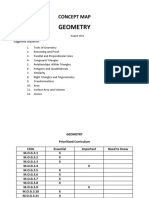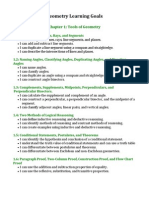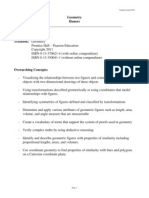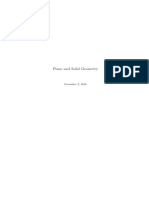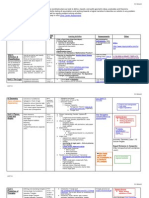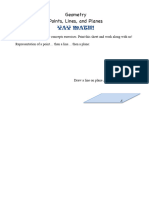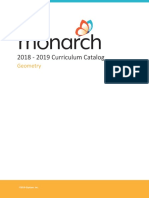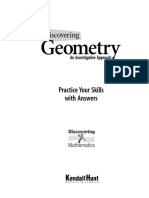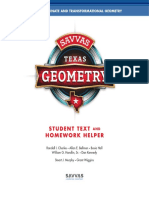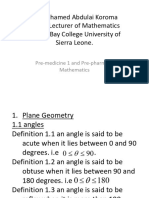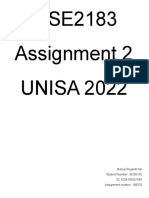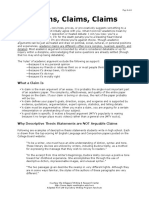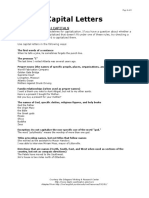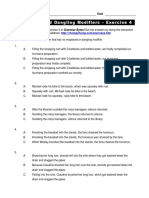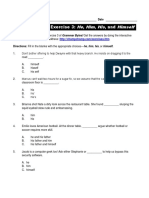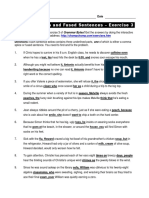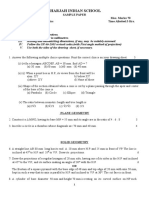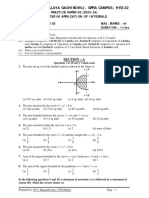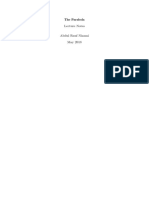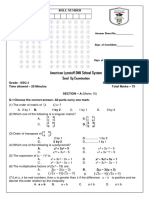Carnegie Learning CCSS Geometry
Uploaded by
jaysakeCarnegie Learning CCSS Geometry
Uploaded by
jaysakeLet's Get This Started!
1.1
Points, Lines, Planes, Rays, and
Line Segments
Let's Move!
1.2
Translating and Constructing Line
Segments
Geometry: A Common Core Program
Key Math Objective
Identify and name points, lines,planes, rays, and line segments.
Use symbolic notation to decribe points, lines, planes, rays, and line segments.
Describe possible intersections of lines and planes.
Identify construction tools.
Distinguish betweena a sketch, a drawing, and a construction.
Determine the distance between two points.
Use the Pythagorean Theorem to derive the Distance Formula.
Apply the Distance Formula on the coordinate plane.
Translate a line segment on the coordinate plane.
Copy or duplicate a line segment by construction.
CCSS
G.CO.1
G.CO.1
G.CO.2
G.CO.4
G.CO.5
G.CO.6
G.CO.12
G.CO.13
Technology
Lesson Title
Talk the Talk
Chapter
Peer Analysis
Tools of Geometry
Worked Examples
This chapter begins by addressing the building blocks of geometry which are the point, the line, and the plane. Students will construct line
segments, midpoints, bisectors, angles, angle bisectors, perpendicular lines, parallel lines, polygons, and points of concurrency. A
translation is a rigid motion that preserves the size and shape of segments, angles, and polygons. Students use the coordinate plane and
algebra to determine the characteristics of lines, segments, and points of concurrency.
Modules
Geometry: A Common Core Program
Key Terms
Point
Line
Collinear points
Plane
Compass
Straightedge
Sketch
Draw
Construct
Coplanar lines
Skew lines
Ray
Endpoint of a ray
Line segment
Endpoints of a line segment
Congruent line segments
Distance Formula
Transformation
Rigid motion
Translation
Pre-image
Image
Arc
CONSTRUCTIONS
Copying a lint segment
Duplicating a line segment
Geometry: A Common Core Program
It's All About Angles
1.4
Translating and Constructing
Angles and Angle Bisectors
Did You Find a Parking Space?
1.5
1.6
Parallel and Perpenddicular Lines
on the Coordinate Plane
Translate an angle on the coordinate plane.
Copy or duplicate an angle by construction.
Bisect an angle by construction.
Determine whether lines are parallel.
Identify and write the equations of lines parallel to given lines.
Determine whether lines are perpendicular.
Identify and write the equations of lines perpendicular to given lines.
Identify and write the equations of horizontal and vertical lines.
Calculate the distance between a line and a point not on a line.
Construct a perpendicular line to a given line.
Making CopiesJust as Perfect as Construct a parallel line to a given line through a point not on the line.
the Original!
Construct an equilateral triangle given the length of one side of the triangle.
Construct an isosceles triangle given the length of one side of the triangle.
Constructing Perpendicular Lines, Construct a square given the perimeter (as the length of a given line segment).
Parallel Lines, and Polygons
Construct a rectangle that is not a square given the perimeter (as the length of a given line
segment).
What's the Point?
1.7
Points of Concurrency
Geometry: A Common Core Program
Construct the incenter, circumcenter, centroid, and orthocenter.
Locate points of concurrency using algebra.
Midpoint
Midpoint Formula
Segment bisector
CONSTRUCTIONS
Bisecting a line segment.
G.CO.1
G.CO.2
G.CO.4
G.CO.5
G.CO.6
G.CO.12
G.CO.1
G.GPE.4
G.GPE.5
G.MG.1
Angle
Angle bisector
CONSTRUCTIONS
Copying an angle
Duplicating an angle
Bisecting an angle
Point-slope form
Perpendicular bisector
G.CO.12
G.CO.12
G.MG.3
CONSTRUCTIONS
A perpendicular line to a given
line through a point on the line
A perpendicular line to a given
line through a point not on the line
Concurrent
Point of concurrency
Circumcenter
Incenter
Median
Centroid
Altitude
Orthocenter
Midpoints and Bisectors
G.CO.12
G.GPE.6
G.MG.1
1.3
Determine the midpoint of a line segment on a coordinate plane.
Use the Midpoint Formula.
Apply the Midpoint Formula on the coordinate plane.
Bisect a line segment using patty paper.
Bisect a line segment by construction.
Locate the midpoint of a line segment.
Treasure Hunt
A Little Dash of Logic
2.1
Foundations for Proof
And Now From a New Angle
2.2
Special Angles and Postulates
Geometry: A Common Core Program
Key Math Objective
Define inductive and deductive reasoning.
Identify methods of reasoning.
Compare and contrast methods of reasoning.
Create examples using inductive and deductive reasoning.
Identify the hypothesis and conslusion of a conditional statement.
Explore the truth values of conditional statements.
Use a trutth table.
Calculate the complement and supplement of an angle.
Classify adjacent angles, linear pairs, and vertical angles.
Differentiate between postulates and theorems.
Differentiate between *Euclidean and non-Euclidean geometries.
CCSS
G.CO.9
G.CO.9
Technology
Lesson Title
Talk the Talk
Chapter
This chapter focuses on the foundations of proof. Paragraph, two-column, construction, and flow chart proofs are presented. Proofs
involving angles and parallel lines are completed.
Peer Analysis
Introduction to Proof
Worked Examples
Modules
Geometry: A Common Core Program
Key Terms
Induction
Deduction
Counterexample
Conditional statement
Propositional form
Propositional variables
Hypothesis
Conclusion
Truth value
Truth table
Supplementary angles
Complementary angles
Adjacent angles
Linear pairs
Vertical angles
Postulate
Theorem
Euclidean geometry
Linear Pair Postulate
Segment Addition Postulate
Angle Addition Postulate
Geometry: A Common Core Program
Forms of Proof
2.3
Paragraph Proof, Two-Column
Proof, Construction Proof, and
Flow Chart Proof
What's Your Proof?
2.4
Angle Postulates and Theorems
Geometry: A Common Core Program
Use the addition and subtraction properties of equality.
Use the reflexsive, substituition, and transitive properties.
Write a paragraph proof.
Complete a two-column proof.
Perform a construction proof.
Complete a flow chart proof.
Use the Corresponding Angle Postulate
Prove the Alterate Interior Angle Theorem
Prove the Alternate Exterior Angle Theorem
Prove the Same-Side Interior Angle Theorem
Prove the Same-Side Exterior Angle Theorem
G.CO.9
Additional Property of Equality
Subtraction Property of Equality
Reflexive Property
Substitution Property
Transitive Property
Flow chart proof
Two-column proof
Paragraph proof
Construction proof
Right Angle Congruence Theorem
Congruent Supplement Theorem
Congruent Complement Theorem
Vertical Angle Theorem
G.CO.9
Corresponding Angle Postulate
Conjecture
Alternate Interior Angle Theorem
Alternate Exterior Angle Theorem
Same-Side Interior Angle Theorem
Same-Side Exterior Angle Theorem
Geometry: A Common Core Program
A Reversed Condition
Write and prove parallel line converse conjectures.
2.5
Parallel Line Converse Theorems
Geometry: A Common Core Program
G.CO.9
Converse
Corresponding Angle Converse
Postulate
Alternate Interior Angle Converse
Theorem
Alternate Exterior Angle Converse
Theorem
Same-Side Interior Angle Converse
Theorem
Same-Side Exterior Angle Converse
Theorem
Tranforming to a New Level!
3.1
3.2
Using Transformations to
Determine Area
Area and Perimeter of
Parallelograms on the Coordinate
Plane
Leavin' On a Jet Plane
3.4
Area and Perimeter of Trapezoids
on the Coordinate Plane
Geometry: A Common Core Program
CCSS
Key Terms
G.CO.6
G.GPE.4
G.GPE.5
G.GPE.7
G.MG.1
G.MG.2
G.MG.3
N/A
G.CO.6
G.GPE.5
G.GPE.7
G.MG.1
N/A
Determine the perimeter of parallelograms on a coordinate plane.
Determine the area of parallelogams on a coordinate plane.
Explore the effects that doubling the area has on the properties of a parallelogram.
G.GPE.5
G.GPE.7
G.MG.1
N/A
Determine the perimeter and area of trapezoids and hexagons on a coordinate plane.
Determine the perimeter of composite figures on the coordinate plane.
G.CO.6
G.GPE.7
G.MG.1
Bases of a trapezoid
Legs of a trapezoid
Determine the areas of squares on a coordinate plane.
Connect transformations of geometric figures with number sense and operations.
Determine the areas of rectangles using transformations.
Looking at Something Familiar in a
Determine the perimeter of triangles on the coordinate plane.
New Way
Determine the area of triangles on the coordinate plane.
Area and Perimeter of Triangles on Explore the effects that doubling the area has on the properties of a triangle.
the Coordinate Plane
Grasshoppers Everywhere!
3.3
Key Math Objective
Technology
Lesson Title
Talk the Talk
Chapter
This chapter focuses on calculating perimeter and area of figures represented on the coordinate plane, through the use of distance,
midpoint, and slope.
Peer Analysis
Perimeter and Area of
Geometric Figures on the
Coordinate Plane
Worked Examples
Modules
Geometry: A Common Core Program
Geometry: A Common Core Program
Composite Figures on the
Coordinate Plane
3.5
Area and Perimeter of Composite
Figures on the Coordinate Plane
Geometry: A Common Core Program
Determine the perimeters and areas of composite figures on a coordinate plane.
Connect transformations of geometric figures with number sense and operations.
Determine perimeters and areas of composite figures using transformations.
G.GPE.7
G.MG.1
Composite figures
Key Math Objective
CCSS
Technology
Lesson Title
Talk the Talk
Chapter
This chapter focuses on three-dimensional figures. The first two lessons address rotating and stacking two-dimensional figures to created
three-dimensional solids. Cavalieris principle is presented and is used to derive the formulas for a volume of a cone, pyramid, and sphere.
The chapter culminates with the topics of cross sections and diagonals in three dimensions.
Peer Analysis
Three-Dimensional Figures
Worked Examples
Modules
Geometry: A Common Core Program
Key Terms
Whirlygigs for Sale!
4.1
Apply rotations to two-dimensional plane figures to create three-dimensional solids.
Rotating Two-Dimensional Figures Describe three-dimensional solids formed by rotations of plane figures through space.
through Space
Cakes and Pancakes
4.2
Translating and Stacking TwoDimensional Figures
G.GMD.4
Disc
Apply translations for two-dimensional plane figures to create three-dimensional solids.
Describe three-dimensional solids formed by translations of plane figures through space.
Build three-dimensional solids by stacking congruent or similar two-dimensional plane figures.
G.GMD.4
G.MG.3
Isometric paper
Right triangular prism
Oblique triangular prism
Right rectangular prism
Oblique rectangular prism
Right cylinder
Oblique cylinder
Explore Cavalieri's Principle for two-dimensional figures (area).
Explore Cavalieri's Principle for three-dimensional objects (volume).
G.GMD.1
G.GMD.2
G.GMD.4
Cavalieri's Principle
Rotate two-dimensional plane figures to generate three-dimensional figures.
Give an informal argument for the volume of cones and pyramids.
G.MG.1
G.GMD.4
N/A
Cavaleieri's Principles
4.3
Applications of Cavalieri's
Principles
Spin to Win
4.4
Volume of Cones and Pyramids
Geometry: A Common Core Program
Geometry: A Common Core Program
Derive the formula for the volume of a sphere
G.GMD.4
Sphere
Radius of a sphere
Diameter of a sphere
Great circle of a sphere
Hemisphere
Annulus
Apply the volume for a pyramid, a cylinder, a cone, and a sphere to solve problems.
G.GMD.3
G.MG.1
N/A
Determine the shapes of cross sections.
Determine the shapes of the intersections of solids and planes.
G.GMD.4
G.MG.1
N/A
G.MG.1
G.MG.3
N/A
Spheres a la Archimedes
4.5
Volume of a Sphere
Turn Up the...
4.6
Using Volume Formulas
Tree Rings
4.7
Cross Sections
4.8
Two Dimensions Meet Three
Dimensions
Diagonals in Three Dimensions
Geometry: A Common Core Program
Use the Pythagorean Theorem to determine the length of a diagonal of a solid.
Use a formula to determine the length of a diagonal of a rectangular solid given the lengths of
three perpendicular edges.
Use a formula to determine the length of a diagonal of a rectangular solid given the diagonal
measurements of three perpendicular sides.
Name That Triangle
5.1
Classifying Triangles on the
Coordinate Plane
Inside Out
5.2
Triangle Sum, Exterior Angle, and
Exterior Inequality Theorems
Trade Routes and Pasta Anyone?
5.3
The Triangle Inequality Theorem
Key Math Objective
CCSS
Key Terms
Determine the coordinates of a third vertex of a triangle, given the coordinates of two vertices
and a decription of the triangle.
Classify a triangle given the locations of its vertices on a coordinate plane.
G.GPE.5
G.MG.1
N/A
Prove the Triangle Sum Theorem
Explore the relationship between the interior angle measures and the side lengths of a
triangle.
Identify the remote interior angles of a triangle.
Identify the exterior angle of a triangle.
Explore the relationship between the exterior angle measures and two remote interior angles
of a triangle.
Prove the Exterior Angle Theorem
Prove the Exterior Angle Inequality Theorem
G.CO.10
G.MG.1
Triangle Sum Theorem
Remote interior angles of a triangle
Exterior Angle Theorem
Exterior Angle Inequality Theorem
Explore the relationship between the side lengths of a triangle and the measures of its
interior angles.
Prove the Triangle Inequality Theorem.
G.CO.10
Triangle Inequality Theorem
5.4
Use the Pythagorean Theorem to explore the relationship between the side lengths of a
triangle and the measures of its interior angles.
Properties of a 45-45-90 Triangle Prove the 45-45-90 Triangle Theorem
G.CO.10
G.MG.1
45-45-90 Triangle Theorem
5.5
Use the Pythagorean Theorem to explore the relationship between the side lengths of a
triangle and the measures of its interior angles.
Properties of a 30-60-90 Triangle Prove the 30-60-90 Triangle Theorem
G.CO.10
G.MG.1
30-60-90 Triangle Theorem
Stamps Around the World
More Stamps, Really?
Geometry: A Common Core Program
Technology
Lesson Title
Talk the Talk
Chapter
This chapter focuses on properties of triangles, beginning with classifying triangles on the coordinate plane. Theorems involving angles and
side lengths of triangles are presented. The last two lessons discuss properties and theorems of 45-45-90 triangles and 30-60-90
triangles.
Peer Analysis
Properties of Triangles
Worked Examples
Modules
Geometry: A Common Core Program
10
Key Math Objective
Big and Small
6.1
Prove that triangles are similar using geometric theorems.
Dilating Triangles to Create Similar Prove that triangles are similar using transformations.
Triangles
Similar Triangles or Not?
6.2
Similar Triangle Theorems
Keep It In Proportion
6.3
Theorems About Proportionality
Geometry: A Common Core Program
Similar triangles
G.SRT.3
G.SRT.5
Angle-Angle Similarity Theorem
Side-Side-Side Similarity Theorem
Included angle
Included side
Side-Angle-Side Similarity Theorem
G.GPE.7
G.SRT.4
G.SRT.5
Angle Bisector/Proportional Side
Theorem
Triangle Proportionality Theorem
Converse of the Triangle
Proportionality Theorem
Proportional Segments Theorem
Triangle Midsegment Theorem
This chapter addresses similar triangles and establishes similar triangle theorems as well as theorems about proportionality. The chapter
leads student exploration of the conditions for triangle similarity and opportunities for applications of similar triangles.
Use constructions to explore similar triangle theorems.
Explore the Angle-Angle (AA) Similarity Theorem
Explore the Side-Side-Side (SSS) Similarity Theorem
Explore the Side-Angle-Side (SAS) Similarity Theorem
Prove the Angle Bisector/Proportional Side Theorem
Prove the Triangle Proportionality Theorem
Prove the Converse of the Triangle Proportionality Theorem
Prove the Proportional Segments Theorem associated with parallel lines.
Prove the Triangle Midsegment Theorem.
CCSS
G.SRT.1.A
G.SRT.1.B
G.SRT.2
G.SRT.5
G.MG.1
Technology
Lesson Title
Talk the Talk
Chapter
Peer Analysis
Similarity Through a
Transformation
Modules
Worked Examples
Geometry: A Common Core Program
Key Terms
11
Geometry: A Common Core Program
Geometric Mean
6.4
More Similar Triangles
Explore the relationships created when an altitude is drawn to the hypotenuse of a right
triangle.
Prove the Right Triangle/Altitude Similarity Theorem.
Use the geometric mean to solve for unknown lengths.
G.SRT.4
G.SRT.5
G.MG.1
Right Triangle/Altitude
Similarity Theorem
Geometric mean
Right Triangle Altitude/Hypotenuse
Theorem
Right Triangle Altitude/Leg Theorem
G.SRT.4
N/A
G.SRT.5
G.MG.1
Indirect measurement
Proving the Pythagorean Theorem
6.5
Prove the Pythagorean Theorem using similar triangles.
Proving the Pythagorean Theorem
Prove the Converse of the Pythagorean Theorem using algebraic reasoning.
and the Converse of the
Pythagorean Theorem
Indirect Measurement
6.6
Application of Similar Triangles
Geometry: A Common Core Program
Identify similar triangles to calculate indirect measurements.
Use proportions to solve for unknown measurements.
12
7.1
7.2
Congruent Triangles
Side-Side-Side
7.3
Side-Side-Side Congruence
Theorem
Side-Angle-Side
7.4
Key Math Objective
Slide, Flip, Turn: The Latest Dance
Translate geometric figures on a coordinate plane.
Craze?
Rotate geometric figures on a coordinate plane.
Translating, Rotating, and
Reflect geometric figures on a coordinate plane
Reflecting Geometric Figures
All The Same To You
Side-Angle-Side Congruence
Theorem
Geometry: A Common Core Program
G.CO.2
G.CO.3
G.CO.5
N/A
G.CO.6
G.CO.7
G.CO.8
N/A
This chapter focuses on proving triangle congruence theorems and using the theorems to determine whether triangles are congruent.
Identify corresponding sides and corresponding angles of congruent triangles.
Explore the relationship between corresponding sides of congruent triangles.
Explore the relationship between corresponding angles of congruent triangles.
Write congruence statements for congruent triangles.
Identify and use rigid motion to create new images.
CCSS
Technology
Lesson Title
Talk the Talk
Chapter
Peer Analysis
Congruence Through
Transformations
Worked Examples
Modules
Geometry: A Common Core Program
Key Terms
Explore the Side-Side-Side Congruence Theorem through constructions.
Explore the Side-Side-Side Congruence Theorem on the coordinate plane.
Prove the Side-Side-Side Congruence Theorum
G.CO.6
G.CO.7
G.CO.8
G.CO.10
G.CO.12
Side-Side-Side Congruence Theorem
Explore Side-Angle-Side Congruence Theorem using constructions.
Explore Side-Angle-Side Congruence Theorem on the coordinate plane.
Prove the Side-Angle-Side Congruence Theorem.
G.CO.6
G.CO.7
G.CO.8
G.CO.10
G.CO.12
Side-Angle-Side Congruent Theorem
13
Geometry: A Common Core Program
Explore the Angle-Side-Angle Congruence Theorem using constructions.
Explore the Angle-Side-Angle Congruence Theorem on the coordinate plane.
G.CO.6
G.CO.7
G.CO.8
G.CO.10
G.CO.12
Angle-Side-Angle Congruence
Theorem
Explore Angle-Angle-Side Congruence Theorem using constructions.
Explore Angle-Angle-Side Congruence Theorem on the coordinate plane.
Prove the Angle-Angle-Side Congruence Theorem.
G.CO.6
G.CO.7
G.CO.8
G.CO.10
G.CO.12
Angle-Angle-Side Congruence
Theorem
Prove that the points on a perpendicular bisector of a line segment are equidistant to the
endpoints of the line segment.
Show that AAA for congruent triangles does not work.
Show that SSA for congruent triangles fors not work.
Use the congruence theorems to determine triangle congruency.
G.CO.6
G.CO.7
G.CO.8
G.CO.9
G.CO.12
N/A
You Shouldn't Make Assumptions
7.5
Angle-Side-Angle Congruence
Theorem
Ahhhhh... We're Sorry We Didn't
Include You
7.6
Angle-Angle-Side Congruent
Theorem
Congruent Triangles in Action
7.7
Using Congruent Triangles
Geometry: A Common Core Program
14
Time to Get Right
8.1
8.2
Right Triangle Congruency
Theorems
Key Math Objective
Prove the Hypotenuse-Leg Congruence Theorem using a two-column proof and construction.
Prove the Leg-Leg, Hypotenuse-Angle, and Leg-Angle Congruence Theorems by relating
them to general triangle congruence theorems.
Apply right triangle congruence theorems.
Identify corresponding parts of congruent triangles.
Use corresponding parts of congrent triangles are congruent to prove angles and segments
are congruent.
CPCTC
Use corresponding parts of congruent triangles are congruent to prove the Isosceles Triangle
Corresponding Parts of Congruent Base Angle Theorem.
Triangles are Congruent
Use corresponding parts of congruent triangles are congruent or prove the Isosceles Triangle
Base Angle Converse Theorem.
Apply corresponding parts of congruent triangles.
Congruence Theorems in Action
8.3
Isosceles Triangle Theorems
Geometry: A Common Core Program
Prove the Isosceles Triangle Base Theorem.
Prove the Isosceles Triangle Vertex Angle Theorem.
Prove the Isosceles Triangle Perpendicular Bisector Theorem.
Prove the Isosceles Triangle Altitude to Congruent Sides Theorem.
Prove the Isosceles Triangle Angle Bisector to Congruent Side Theorem.
CCSS
Key Terms
G.CO.6
G.CO.7
G.CO.8
G.CO.10
G.CO.12
G.MG.1
Hypotenuse-Leg (HL) Congruence
Theorem
Leg-Leg (LL) Congruence Theorem
Hypotenuse-Angle (HA) Congruence
Theorem
Leg-Angle (LA) Congruence Theorem
G.CO.10
G.MG.1
Corresponding parts of congruent
triangles are congruent (CPCTC)
Isosceles Triangle Base Angle
Theorem
IsoscelesTriangle Base Angle
Converse Theorem
G.CO.10
G.MG.1
Vertex angle
Isosceles Triangle Base Theorem
Isosceles Triangle Vertex Angle
Theorem
Isosceles Triangle Perpendicular
Bisector Theorem
Isosceles Triangle Altitude to
Congruent Sides Theorem
Isosceles Triangle Angle Bisector to
Congruent Sides Theorem
Technology
Lesson Title
Talk the Talk
Chapter
This chapter covers triangle congruence, including right triangle and isosceles triangle congruence theorems. Lessons provide opportunities
for students to explore the congruence of corresponding parts of congruent triangles as well as continuing work with proof, introducing
indirect proof, or proof by contradiction. Throughout, students apply congruence theorems to solve problems.
Peer Analysis
Using Congruence Theorems
Worked Examples
Modules
Geometry: A Common Core Program
15
Geometry: A Common Core Program
Making Some Assumptions
8.4
Inverse, Contrapositive, Direct
Proof, and Indirect Proof
Geometry: A Common Core Program
Write the inverse and contrapositive of a conditional statement.
Differentiate between direct and indirect proof.
Use indirect proof.
G.CO.10
G.MG.1
Inverse
Contrapositive
Direct proof
Indirect proof or proof by
contradiction
Hinge Theorem
Hinge Converse Theorem
16
Introduction to Trigonometry
The Tangent Ratio
9.2
Tangent Ratio, Cotangent Ratio,
and Inverse Tangent
The Sine Ratio
9.3
Sine Ratio, Cosecant Ratio, and
Inverse Sine
The Cosine Ratio
9.4
Consine Ratio, Secant Ratio, and
Inverse Cosine
Geometry: A Common Core Program
Technology
Talk the Talk
CCSS
Peer Analysis
Three Angles Measure
9.1
Key Math Objective
Lesson Title
Chapter
Worked Examples
Trigonometry
Key Terms
Explore trigonometric ratios as measurement conversions.
Analyze the properties of similar right triangles.
G.SRT.3
G.SRT.5
G.SRT.6
Reference angle
Opposite side
Adgacent side
Use the tangent ratio in a right triangle to solve for unknown side lengths.
Use the cotangent ratio in a right triangle to solve for unknown side lengths.
Relate the tangent ratio to the cotangent ratio.
Use the inverse tangent in a right triangle to solve for unknown angle measures.
G.SRT3
G.SRT.5
G.SRT.6
G.SRT.8
G.MG.1
Rationalizing the denominator
Tangent (tan)
Cotangent (cot)
Inverse tangent
Use the sine ratio in a right triangle to solve for unknown side lengths.
Use the cosecant ratio in a right triangle to solve for unknown side lengths.
Relate the sine ratio to the cosecant ratio.
Use the inverse sine in a right triangle to solve for unknown angle measures.
G.SRT.8
G.MG.1
Sine (sin)
Cosecant (csc)
Inverse sine
Use the cosine ratio in a right triangle to solve for unknown side lengths.
Use the secant ratio in a right triangle to solve for unknown side lengths.
Relate the cosine ratio to the secant ratio.
Use the inverse cosine in a right triangle to solve for unknown angle measures.
G.SRT.8
G.MG.1
Cosine (cos)
Secant (sec)
Inverse cosine
This chapter introduces students to trigonometric ratios using right triangles. Lessons provide opportunities for students to discover and
analyze these ratios and solve application problems using them. Students also explore the reciprocals of the basic trigonometric ratios sine,
cosine, and tangent, along with their inverses to determine unknown angle measures. Deriving the Law of Sines and the Law of Cosines
extends students understanding of trigonometry to apply to all triangles.
Modules
Geometry: A Common Core Program
17
Geometry: A Common Core Program
We Compliment Each Other!
9.5
Complement Angle Relationships
Time to Derive!
9.6
Explore complement angle relationships in a right triangle.
Solve problems using complement angle relationships.
Derive the formula for the area of a triangle using the sine function.
Deriving the Triangle Area
Derive the Law of Sines.
Formula, the Law of Sines, and the Derive the Law of Cosines.
Law of Cosines
Geometry: A Common Core Program
G.SRT.7
G.SRT.8
G.MG.1
N/A
G.SRT.9
G.SRT.10
G.SRT.11
G.MG.1
Law of Sines
Law of Cosines
18
Squares and Rectangles
10.1
Properties of Squares and
Rectangles
Parallelograms and Rhombi
10.2
Properties of Parallelograms and
Rhombi
Geometry: A Common Core Program
CCSS
Key Terms
Prove the Perpendicular/Parallel Line Theorem.
Construct a square and a rectangle
Determine the properties of a square and rectangle.
Prove the properties of a square and a rectangle.
Solve problems using the properties of a square and a rectangle.
G.CO.11
G.CO.12
G.SRT.8
G.GPE.5
G.MG.1
Perpendicular/Parallel Line Theorem
Construct a parallelogram.
Construct a rhombus.
Prove the properties of a parallelogram.
Prove the properties of a rhombus.
Solve problems using the properties of a parallelogram and a rhombus.
G.CO.11
G.CO.12
G.GPE.5
G.MG.1
Parallelogram/Congruent-Parallel
Side Theorem
G.CO.11
G.SRT.8
G.GPE.5
G.CO.12
G.MG.1
Base angles of a trapezoid
Isosceles trapezoid
Biconditional statement
Midsegment
Trapezoid Midsegment Theorem
Construct a kite and a trapezoid.
Determine the properties of a kite and a trapezoid.
Prove the properties of a kites and trapezoids.
Properties of Kites and Trapezoids
Solve problems using the properties of kites and trapezoids.
Kites and Trapezoids
10.3
Key Math Objective
Technology
Lesson Title
Talk the Talk
Chapter
This chapter focuses on properties of squares, rectangles, parallelograms, rhombi, kites, and trapezoids. The sum of interior and exterior
angles of polygons is also included.
Peer Analysis
Properties of Quadrilaterals
Worked Examples
10
Modules
Geometry: A Common Core Program
19
Geometry: A Common Core Program
10.4
Write the formula for the sum of the measures of the interior angles of any polygon.
Calculate the sum of the measures of the interior angles of any polygon, given the number
of sides.
Interior Angles of a Polygon
Calculate the number of sides of a polygon, given the sum of the measures of the interior
angles.
Sum of the Interior Angle Measures
Write a formula for the measure of each interior angle of any regular polygon.
of a Polygon
Calculate the measure of an interior angle of a regular polygon, given the number of sides.
Calculate the number of sides of a regular polygon, given the sum of the measures of the
interior angles.
G.CO.9
G.SRT.8
G.MG.1
Interior angle of a polygon
Write the formula for the sum of the exterior angles of any polygon.
Calculate the sum of the exterior angles of any polygon, given the number of sides.
Write a formula for the measure of each exterior angle of any regular polygon.
Calculate the measure of an exterior angle of a regular polygon, given the number of sides.
Calculate the number of sides of a regular polygon, given measures of each exterior angle.
G.CO.9
G.CO.12
G.SRT.8
G.MG.1
Exterior angle of a polygon
G.CO.12
N/A
G.GPE.4
G.GPE.5
G.MG.1
G.MG.3
N/A
Exterior and Interior Angle
Measurement Interactions
10.5
Sum of the Exterior Angle
Measures of a Polygon
Quadrilateral Family
10.6
List the properties of various quadrilaterals.
Categorize quadrilaterals based upon their properties.
Categorizing Quadrilaterals Based
Construct quadrilaterals given a diagonal.
on Their Properties
Name That Quadrilateral
10.7
Classifying Quadrilaterals on the
Coordinate Plane
Geometry: A Common Core Program
Determine the coordinates of the fourth vertex, given the coordinates of three vertices and a
description of the quadrilateral.
Classify a quadrilateral given the location of its vertices on a coordinate plane.
20
Riding a Ferris Wheel
11.1
Introduction to Circles
Take the Wheel
11.2
Central Angles, Inscribed Angles,
and Intercepted Arcs
Manhole Covers
11.3
Measuring Angles Inside and
Outside of Circles
Geometry: A Common Core Program
G.CO.1
G.C.1
G.C.2
G.MG.1
Center of a circle
Radius
Chord
Diameter
Secant of a circle
Tangent of a circle
Point of tangency
Central angle
Inscribed angle
Arc
Major arc
Minor arc
Semicircle
Determine the measure of various arcs.
Use the Arc Addition Postulate.
Determine the measure of central angles and inscribed angles.
Prove the Inscribed Angle theorem.
Prove the Parallel Lines Congruent Arcs Theorem.
G.CO.1
G.C.2
G.MG.1
Degree measure of an arc
Adjacent arcs
Arc Addition Postulate
Intercepted arc
Inscribed Angle Theorem
Parallel Lines-Congruent Arc
Theorem
Determine the measures of angles formed by two chords.
Determine the measure of angles formed by two secants.
Determine the measure of angles formed by a tangent and a secant.
Determine the measure of the angles formed by two tangents.
Prove the Interior Angles of a Circle Theorem.
Prove the Exterior Angles of a Circle Theorem.
Prove the Tangent to a Circle Theorem.
G.C.2
G.MG.1
Interior Angles of a Circle Theorem
Exterior Angles of a Circle Theorem
Tangent to a Circle Theorem
This chapter reviews information about circles, and then focuses on angles and arcs related to a circle, chords, and tangents. Several
theorems related to circles are proven throughout the chapter.
Key Math Objective
Review the definition of line segments related to a circle such as chord, secant, and tangent.
Review the definitions of points related to a circle such as center and point of tangency.
Review the definitions of angles related to a circle such as central angle and inscribed angle.
Review the definitions of arcs related to a circle such as major arc, minor arc, and semicircle.
Prove all circles are similar using rigid motion.
CCSS
Technology
Lesson Title
Talk the Talk
Chapter
Peer Analysis
Circles
Modules
11
Worked Examples
Geometry: A Common Core Program
Key Terms
21
Geometry: A Common Core Program
Color Theory
11.4
Chords
Solar Eclipses
11.5
Tangents and Secants
Geometry: A Common Core Program
Determine the relationships between a chord and a diameter of a circle.
Determine the relationships between congruent chords and their minor arcs.
Prove the Diameter-Chord Theorem.
Prove the Equidistant Chord Theorem.
Prove the Equidistant Chord Converse Theorem.
Prove the Congruent Chord-Congruent Arc Theorem.
Prove the Congruent Chord-Congruent Arc Converse Theorem.
Prove the Segment-Chord Theorem.
Determine the relationship between a tangent line and a radius.
Determine the relationshop between congruent tangent segments.
Prove the Tangent Segment Theorem.
Prove the Secant Segment Theorem.
Prove the Secant Tangent Theorem.
G.C.2
G.MG.1
Diameter-Chord Theorem
Equidistant Chord Theorem
Equidistant Chord Converse Theorem
Congruent Chord-Congruent Arc
Theorem
Congruent Chord-Congruent Arc
Converse Theorem
Segments of a chord
Segment-Chord Theorem
G.C.4
G.MG.1
Tangent segment
Tangent Segment Theorem
Secant segment
External secant segment
Secant Segment Theorem
Secant Tangent Theorem
22
Replacement for a Carpenter's
Square
12.1
Inscribed and Circumscribed
Triangles and Quadrilaterals
Gears
12.2
Arc Lengths
Playing Darts
12.3
Sectors and Segments of a Circle
Geometry: A Common Core Program
Distinguish between arc measure and arc length.
Use a formula to solve for arc length in degree measures.
Distinguish between degree measure and radian measure.
Use a formula to solve for arc length in radian measures.
G.C.5
G.MG.1
Arc length
Radian
Determine the area of sectors of a circle.
Derive the formula for the area of a sector.
Determine the area of segments of a circle.
G.C.5
G.MG.1
Concentric circles
Sector of a circle
Segment of a circle
This chapter explores inscribed and circumscribed polygons as well as circles. Students determine relationships between central angles,
arcs, arc lengths, areas of parts of circles, as well as linear velocity and angular velocity.
Key Math Objective
Inscribe a triangle in a circle.
Explore properties of a triangle inscribed in a circle.
Circumscribe a triangle about a circle.
Inscribe a quadrilateral in a circle.
Explore properties of a quadrilateral inscribed in a circle.
Circumscribe a quadrilateral about a circle.
Prove the Inscribed Right Triangle-Diameter Theorem.
Prove the Inscribed Right Triangle-Diameter Converse Theorem.
Prove the Inscribed Quadrilateral-Opposite Angles Theorem.
CCSS
G.C.3
Technology
Lesson Title
Talk the Talk
Chapter
Peer Analysis
Arcs and Sectors of Circles
Modules
12
Worked Examples
Geometry: A Common Core Program
Key Terms
Inscribed polygon
Inscribed Right Triangle-Diameter
Theorem
Inscribed Right Triangle-Diameter
Converse Theorem
Circumscribed polygon
Inscribed Quadrilateral-Opposite
Angles Theorem
23
Geometry: A Common Core Program
Circle K. Excellent!
12.4
Circle Problems
Geometry: A Common Core Program
Use formulas associated with circles to solve problems.
Use theorems associated with circles to solve problems.
Use angular velocity and linear velocity to solve problems.
G.MG.1
G.MG.3
Linear velocity
Angular velocity
24
The Coordinate Plane
13.1
Circles and Polygons on the
Coordinate Plane
Bring On The Algeba
13.2
Derive the Equation for a Circle
Is That Point on the Circle?
13.3
Determining Points on a Circle
Key Math Objective
CCSS
G.GPE.4
G.GPE.5
G.MG.1
N/A
Use the Pythagorean Theorem to derive the equation of a circle given the center and radius.
Distinguish between the equation of a circle written in general form and the equation of a
circle written in standard form (center-radius form)
Complete the square to determine the center and radius of a circle.
G.GPE.1
G.SRT.8
N/S
Use the Pythagorean Theorem to determine if a point lies on a circle on the coordinate plane
given the circles center at the origin, the radius of the circle, and the coordinates of the point.
Use the Pythagorean Theorem to determine if a point lies on a circle on the coordinate plane
given the circles center not at the origin, the radius of the circle, and the coordinates of the
point.
Use rigid motion to transform a circle about the coordinate plane to determine if a point lies
on a circles image given the pre-images center, radius, and the coordinates of the point.
Determine the coordinate of a point that lies on a circle given the location of the center point
and the radius of the circle.
Use the Pythagorean Theorem to determine the coordinates of a point that lies on a circle.
G.SRT.8
G.GPE.4
G.MG.1
N/A
G.GPE.2
Locus of points
Parabola
Focus on a parabola
Directrix of a parabola
General form of a parabola
Standard form of a parabola
Axis of summetry
Vertex of a parabola
Concavity
Derive the equation of a parabola given the focus and directix.
Equation of a Parabola
Geometry: A Common Core Program
Key Terms
Apply theorems to circles in a coordinate plane.
Classify polygons on the coordinate plane.
Use midpoints to determine characteristics of polygons.
Distinguish between showing something is true under certain conditions, and proving it is
always true.
The Parabola
13.4
Technology
Lesson Title
Talk the Talk
Chapter
This chapter explores circles, polygons, and parabolas on the coordinate plane. Key characteristics are used to write equations for these
geometric figures.
Peer Analysis
Circles and Parabolas
Worked Examples
13
Modules
Geometry: A Common Core Program
25
Geometry: A Common Core Program
Simply Parabolic
Solve problems using characteristics of parabolas.
13.5
G.GPE.2
N/A
More with Parabolas
Geometry: A Common Core Program
26
14.1
These Are a Few of My Favorite
Things
Modeling Probability
It's in the Cards
14.2
Compound Sample Spaces
And?
14.3
Compound Probability with "And"
Or?
14.4
Compound Probability with "Or"
Geometry: A Common Core Program
Key Math Objective
CCSS
Key Terms
S.CP.1
Outcome
Sample space
Event
Probability
Probability model
Uniform probability model
Complement of an event
Non-uniform probability model
Develop a rule to determine the total number of outcomes in a sample space without listing
each event.
Classify events as independent or dependent.
Use the Counting Principle to calculate the size of sample spaces.
S.CP.1
Tree diagram
Organized list
Set
Element
Disjoint sets
Intersecting sets
Independent events
Dependent events
Counting Principle
Determine the probability of two or more independent events.
Determine the probability of two or more dependent events.
S.CP.2
S.CP.8
Compound event
Rule of Compound Probability
involving "and"
Determine the probability of one or another independent events.
Determine the probability of one or another dependent events.
S.CP.7
Addition Rule for Probability
List the sample space for situations involving probability.
Construct a probability model for a situation.
Differentiate between uniform and non-uniform probability models.
Technology
Lesson Title
Talk the Talk
Chapter
This chapter investigates compound probability with an emphasis toward modeling and analyzing sample spaces to determine rules for
calculating probabilities in different situations. Students explore various probability models and calculate compound probabilities with
independent and dependent events in a variety of problem situations. Students use technology to run experimental probability simulations.
Peer Analysis
Probability
Modules
14
Worked Examples
Geometry: A Common Core Program
27
Geometry: A Common Core Program
And, Or, and More!
14.5
Calculate compound probabilities with and without replacement.
S.CP.2
S.CP.8
N/A
Simulate events using the random number generator on a graphing calculator.
Compare experimental and theoretical probability.
S.IC.2
Simulation
Theoretical probability
Experimental probability
Calculating Compound Probability
Do You Have a Better Chance of
Winning the Lottery or Getting
Struck by Lightning?
14.6
Investigate Magnitude through
Theoretical Probability and
Experimantal Probability
Geometry: A Common Core Program
28
Key Math Objective
CCSS
Compound Probability for Data
Displayed in Two-Way Tables
It All Depends
15.2
Conditional Probability
Counting
15.3
Permutations and Combinations
Geometry: A Common Core Program
Peer Analysis
Key Terms
Determine probabilities of compound events for data displayed in two-way tables.
Determine relative frequencies of events.
S.CP.4
Two-way table
Frequency table
Two-way frequency table
Contingency table
Catagorical data
Qualitative data
Relative frequency
Two-way relative frequency table
Use conditional probability to determine the probability of an event given that another event
has occurred.
Use conditional probability to determine whether or not events are independent.
S.CP.3
S.CP.5
S.CP.6
Conditional probability
Use permutations to calculate the size of sample spaces.
Use combinations to calculate the size of sample spaces.
Use permutations to calculate probabilities.
Use combinations to calculate probabilities.
Calculate permutations with repeated elements.
Calculate circular permutations.
S.CP.9
Factorial
Permutation
Circular permutation
Combination
Left, Left, Left, Right, Left
15.1
Technology
Lesson Title
Talk the Talk
Chapter
Worked Examples
15
This chapter addresses more compound probability concepts and more counting strategies. Compound probability concepts are presented
using two-way frequency tables, conditional probability, and independent trials. The counting strategies include permutations,
More Probability and Counting
permutations with repetition, circular permutations, and combinations. The last lesson focuses on geometric probability and expected
value.
Modules
Geometry: A Common Core Program
29
Geometry: A Common Core Program
Trials
15.4
Independent Trials
To Spin or Not to Spin
15.5
Expected Value
Geometry: A Common Core Program
Calculate the probability of two trials of two independent events.
Calculate the probability of multiple trials of two independent events.
Determine the formula for calculating the probability of multiple trials of independent events.
S.CP.9
N/A
Determine geometric probability.
Calculate the expected value of an event.
S.MD.6
S.MD.7
Geometric probability
Expected value
30
You might also like
- Geometry Honors Curriculum Guide CCSD 2024-2025No ratings yetGeometry Honors Curriculum Guide CCSD 2024-202523 pages
- Introduction To Plane Geometry: The Improving Mathematics Education in Schools (TIMES) ProjectNo ratings yetIntroduction To Plane Geometry: The Improving Mathematics Education in Schools (TIMES) Project20 pages
- Unit:06 Common Core Math 6.1 Assessment Answer JournalNo ratings yetUnit:06 Common Core Math 6.1 Assessment Answer Journal32 pages
- Mindworkzz Formula Sheet and Students NotesNo ratings yetMindworkzz Formula Sheet and Students Notes40 pages
- Co-Ordinate Geometry-Made Easy by Deepak Bhardwaj83% (6)Co-Ordinate Geometry-Made Easy by Deepak Bhardwaj463 pages
- Deepak Bhardwaj-Co-ordinate Geometry Made Easy-Laxmi Publications (2008) PDFNo ratings yetDeepak Bhardwaj-Co-ordinate Geometry Made Easy-Laxmi Publications (2008) PDF463 pages
- 2018 - 2019 Curriculum Catalog: GeometryNo ratings yet2018 - 2019 Curriculum Catalog: Geometry7 pages
- Lecture Plane Analytic and Solid GeometryNo ratings yetLecture Plane Analytic and Solid Geometry201 pages
- Geometry Honors Syllabus Final 2014-2015No ratings yetGeometry Honors Syllabus Final 2014-20154 pages
- SMJK Tiong Hua, Sandakan Yearly Lesson Plan Mathematics Form 3 2017No ratings yetSMJK Tiong Hua, Sandakan Yearly Lesson Plan Mathematics Form 3 201718 pages
- Misplaced and Dangling Modifiers - Exercise 4: Name DateNo ratings yetMisplaced and Dangling Modifiers - Exercise 4: Name Date4 pages
- Pronoun Case - Exercise 3:, ,, And: He Him His HimselfNo ratings yetPronoun Case - Exercise 3:, ,, And: He Him His Himself4 pages
- Misplaced and Dangling Modifiers - Exercise 4: Name DateNo ratings yetMisplaced and Dangling Modifiers - Exercise 4: Name Date4 pages
- 2003 Elimination - Metrobank-mtap-Decs-ncr Math Challenge Grade 567% (3)2003 Elimination - Metrobank-mtap-Decs-ncr Math Challenge Grade 551 pages
- Trigonometry (M102) Course Specification: A2. Enumerate The Application of TrigonometryNo ratings yetTrigonometry (M102) Course Specification: A2. Enumerate The Application of Trigonometry5 pages
- 2009 Metrobank-Mtap-Deped Math Challenge National Finals, Fourth-Year Level 4 April 2009 Questions, Answers, and Solutions50% (2)2009 Metrobank-Mtap-Deped Math Challenge National Finals, Fourth-Year Level 4 April 2009 Questions, Answers, and Solutions9 pages
- Congruence and Similarity JkK6nsqSM5hShH0yNo ratings yetCongruence and Similarity JkK6nsqSM5hShH0y24 pages
- WK 7-8 - Using The Distance Formula in Proving Geometric Properties & Equation of A Circle Center at The OriginNo ratings yetWK 7-8 - Using The Distance Formula in Proving Geometric Properties & Equation of A Circle Center at The Origin38 pages
- Chapter 5: Vectors: 6. Addition and Subtraction VectorsNo ratings yetChapter 5: Vectors: 6. Addition and Subtraction Vectors11 pages
- A-Math - Sec 4 - Prelims Exam Paper - 2023 - Ngee Ann SecNo ratings yetA-Math - Sec 4 - Prelims Exam Paper - 2023 - Ngee Ann Sec94 pages
- Maths Class Xii Chapter 08 Application of Integrals Practice Paper 08No ratings yetMaths Class Xii Chapter 08 Application of Integrals Practice Paper 083 pages
- Geometry - DPP 01 - Ioqm Training Camp 2024No ratings yetGeometry - DPP 01 - Ioqm Training Camp 20243 pages


